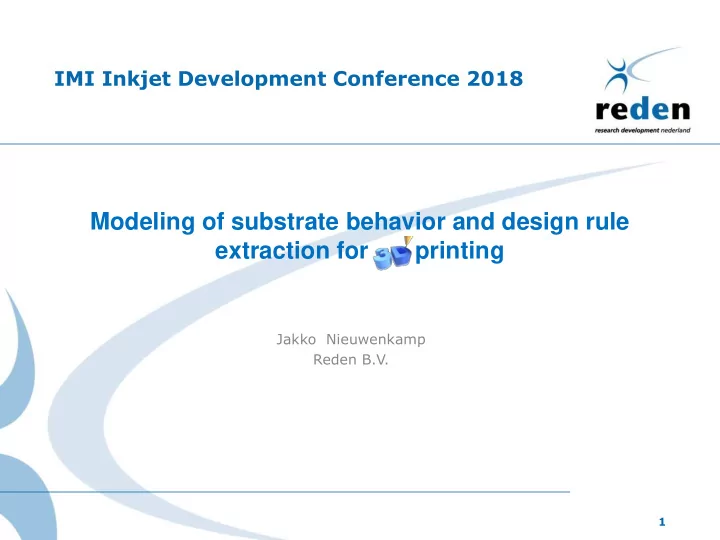

IMI Inkjet Development Conference 2018 Modeling of substrate behavior and design rule extraction for printing Jakko Nieuwenkamp Reden B.V. 1
IMI Europe Inkjet Development Conference Contents • Introducing Reden • Substrate handling – Example 1 – Example 2 – Example 3 • Analysing 3D printed structures 2
Introducing Reden DOMAINS Thermal Mechanical Acoustic Fluid and gases Multi physics 3
Substrate handling Example 1 Goal: Optimize the design for paper transport and alignment. Steps: Wheel 1. Create and validate a model skew Transportation Table wheel 2. Model reduction for easy optimization and evaluation (DoE) Paper sheet 3. Optimize the design 4
Example 1 DoE 5
Example 1 MrReves 6
Substrate handling Example 2 Example process Step 1: Paper is transported with a relative high moisture content Step 2: Paper is dried Step 3: Ink is applied (increase in moisture level in two steps) Step 4: Final transport 7
Substrate handling Example 3 8
Analyzing 3D printed structures HYBMAN project Goal: Hyb-Man exploits the combination of additive manufacturing (also referred to as 3D printing) and 3D integration of electronic parts. 9
Analyzing 3D printed structures HYBMAN project Photo courtesy of Neotech AMT 10
Analyzing 3D printed structures Goals Question: What’s makes the analyses of 3d printed structures complicated? Answer: • The printing process settings effect the material behavior significantly – Anisotropic structural and thermal material behavior – Micro scale geometry influences the macro structure (multi scale) • Significant residual stresses and unwanted deformation can occur during the printing process 11
Analyzing 3D printed structures Goal Goal: Develop analyses methods that allow us to predict the performance of 3D printed objects with integrated electronics. 12
Analyzing 3D printed structures 2 Step approach Printed part Printing path Process analyses Product analyses Location Process dependent material Performance parameters behavior Stress Building Processed Strain material geometry Temperature Residual stresses Loading 13
Analyzing 3D printed structures Process analyses Prediction of: • Thermal field • Residual stresses • Geometry on micro level • Material behavior on macro level 14
Analyzing 3D printed structures Process analyses Prediction of: • Thermal field • Residual stresses • Geometry on micro level • Material behavior on macro level 15
Analyzing 3D printed structures Process analyses Prediction of: • Thermal field • Residual stresses • Geometry on micro level • Material behavior on macro level 16
Analyzing 3D printed structures Product analyses Prediction of: • Thermal field • Stress/strain field • Failure Photos courtesy of Philips 17
Analyzing 3D printed structures Product analyses Prediction of: • Thermal field • Stress/strain field • Failure Metal Heat Sink ℎ 𝑑𝑝𝑜𝑤 = 5 𝑋/𝑛 2 𝐿 ; 𝜗 = 0.8 ; 𝑈 𝑠𝑝𝑝𝑛 = 20 °𝐷 Symmetry plane 0.5 Watt Heat Source 18
Analyzing 3D printed structures Product analyses Prediction of: • Thermal field • Stress/strain field • Failure Resulting stiffnesses 19
IMI Europe Inkjet Development Conferences 2018 Thank you for your attention? Jakko Nieuwenkamp j.Nieuwenkamp@reden.nl, www.reden.nl 20
Recommend
More recommend